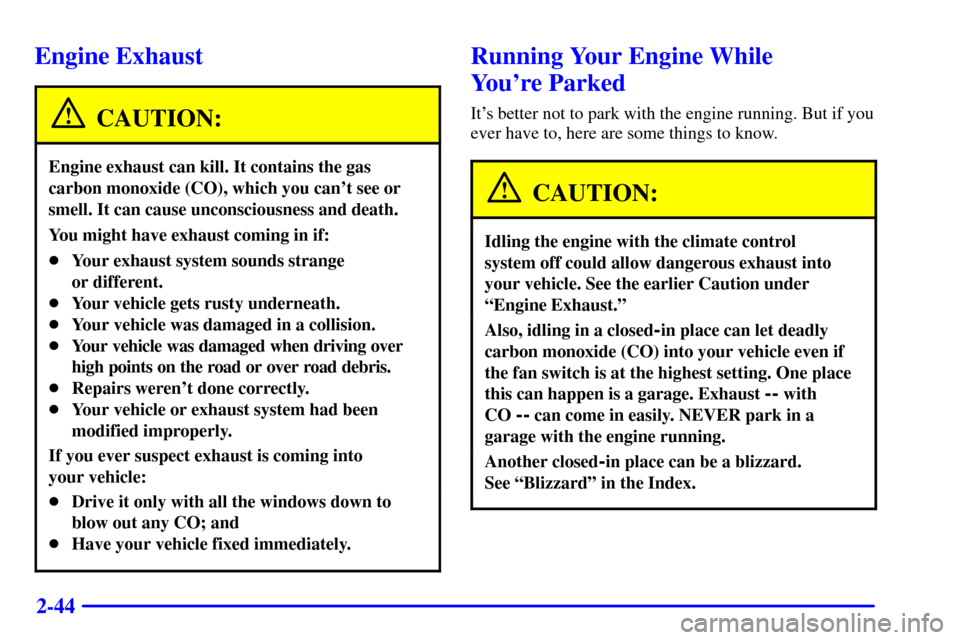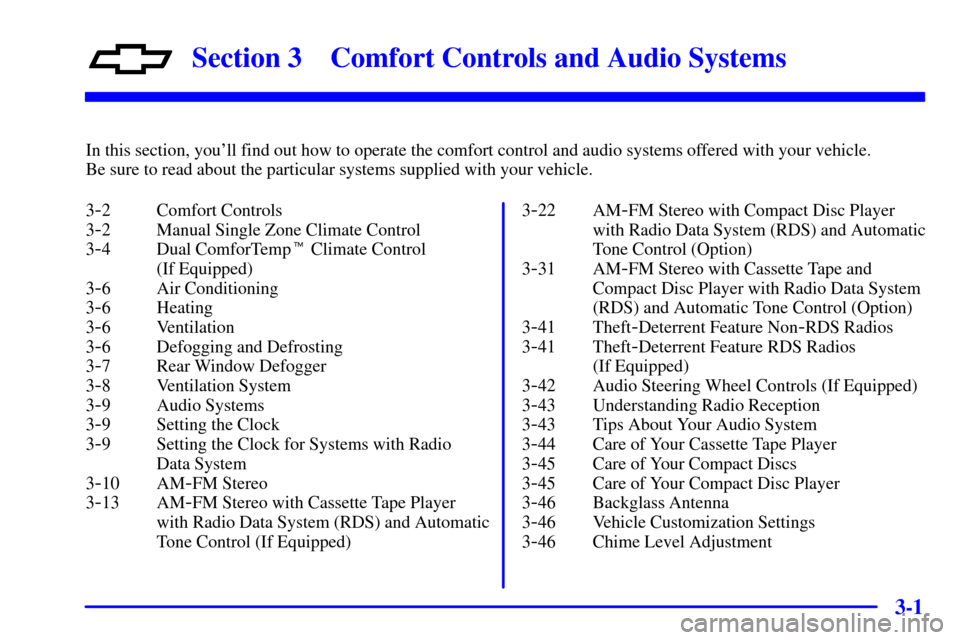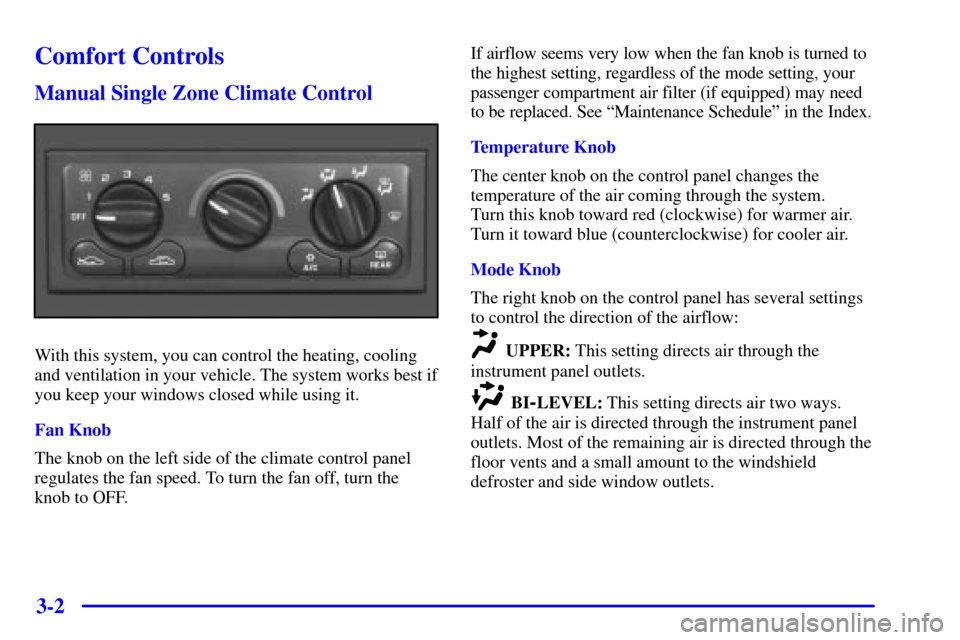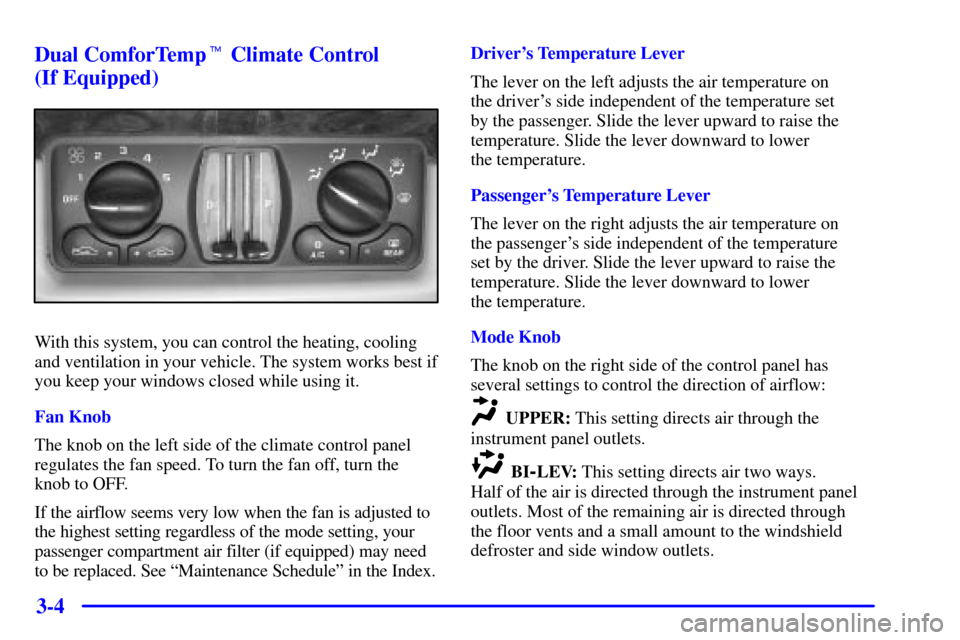Page 114 of 392

2-44
Engine Exhaust
CAUTION:
Engine exhaust can kill. It contains the gas
carbon monoxide (CO), which you can't see or
smell. It can cause unconsciousness and death.
You might have exhaust coming in if:
�Your exhaust system sounds strange
or different.
�Your vehicle gets rusty underneath.
�Your vehicle was damaged in a collision.
�Your vehicle was damaged when driving over
high points on the road or over road debris.
�Repairs weren't done correctly.
�Your vehicle or exhaust system had been
modified improperly.
If you ever suspect exhaust is coming into
your vehicle:
�Drive it only with all the windows down to
blow out any CO; and
�Have your vehicle fixed immediately.
Running Your Engine While
You're Parked
It's better not to park with the engine running. But if you
ever have to, here are some things to know.
CAUTION:
Idling the engine with the climate control
system off could allow dangerous exhaust into
your vehicle. See the earlier Caution under
ªEngine Exhaust.º
Also, idling in a closed-in place can let deadly
carbon monoxide (CO) into your vehicle even if
the fan switch is at the highest setting. One place
this can happen is a garage. Exhaust
-- with
CO
-- can come in easily. NEVER park in a
garage with the engine running.
Another closed-in place can be a blizzard.
See ªBlizzardº in the Index.
Page 145 of 392
2-75
The main components of your instrument panel are listed here:
A. Instrument Panel Fuse Block
B. Traction Control On/Off Switch (If Equipped)
C. Multifunction Lever
D. Audio Steering Wheel Controls (Option)
E. Hazard Warning Flasher Switch
F. Audio System
G. Exterior Lamp ControlsH. Remote Trunk Release
I. Hood Release
J. Steering Wheel Cruise Control Switches
(If Equipped)
K. Ignition Switch
L. Center Console Shift Lever (If Equipped)
M. Climate Controls
Page 171 of 392

3-
3-1
Section 3 Comfort Controls and Audio Systems
In this section, you'll find out how to operate the comfort control and audio systems offered with your vehicle.
Be sure to read about the particular systems supplied with your vehicle.
3
-2 Comfort Controls
3
-2 Manual Single Zone Climate Control
3
-4 Dual ComforTemp� Climate Control
(If Equipped)
3
-6 Air Conditioning
3
-6 Heating
3
-6 Ventilation
3
-6 Defogging and Defrosting
3
-7 Rear Window Defogger
3
-8 Ventilation System
3
-9 Audio Systems
3
-9 Setting the Clock
3
-9 Setting the Clock for Systems with Radio
Data System
3
-10 AM-FM Stereo
3
-13 AM-FM Stereo with Cassette Tape Player
with Radio Data System (RDS) and Automatic
Tone Control (If Equipped)3
-22 AM-FM Stereo with Compact Disc Player
with Radio Data System (RDS) and Automatic
Tone Control (Option)
3
-31 AM-FM Stereo with Cassette Tape and
Compact Disc Player with Radio Data System
(RDS) and Automatic Tone Control (Option)
3
-41 Theft-Deterrent Feature Non-RDS Radios
3
-41 Theft-Deterrent Feature RDS Radios
(If Equipped)
3
-42 Audio Steering Wheel Controls (If Equipped)
3
-43 Understanding Radio Reception
3
-43 Tips About Your Audio System
3
-44 Care of Your Cassette Tape Player
3
-45 Care of Your Compact Discs
3
-45 Care of Your Compact Disc Player
3
-46 Backglass Antenna
3
-46 Vehicle Customization Settings
3
-46 Chime Level Adjustment
Page 172 of 392

3-2
Comfort Controls
Manual Single Zone Climate Control
With this system, you can control the heating, cooling
and ventilation in your vehicle. The system works best if
you keep your windows closed while using it.
Fan Knob
The knob on the left side of the climate control panel
regulates the fan speed. To turn the fan off, turn the
knob to OFF.If airflow seems very low when the fan knob is turned to
the highest setting, regardless of the mode setting, your
passenger compartment air filter (if equipped) may need
to be replaced. See ªMaintenance Scheduleº in the Index.
Temperature Knob
The center knob on the control panel changes the
temperature of the air coming through the system.
Turn this knob toward red (clockwise) for warmer air.
Turn it toward blue (counterclockwise) for cooler air.
Mode Knob
The right knob on the control panel has several settings
to control the direction of the airflow:UPPER: This setting directs air through the
instrument panel outlets.
BI-LEVEL: This setting directs air two ways.
Half of the air is directed through the instrument panel
outlets. Most of the remaining air is directed through the
floor vents and a small amount to the windshield
defroster and side window outlets.
Page 174 of 392

3-4 Dual ComforTemp� Climate Control
(If Equipped)
With this system, you can control the heating, cooling
and ventilation in your vehicle. The system works best if
you keep your windows closed while using it.
Fan Knob
The knob on the left side of the climate control panel
regulates the fan speed. To turn the fan off, turn the
knob to OFF.
If the airflow seems very low when the fan is adjusted to
the highest setting regardless of the mode setting, your
passenger compartment air filter (if equipped) may need
to be replaced. See ªMaintenance Scheduleº in the Index.Driver's Temperature Lever
The lever on the left adjusts the air temperature on
the driver's side independent of the temperature set
by the passenger. Slide the lever upward to raise the
temperature. Slide the lever downward to lower
the temperature.
Passenger's Temperature Lever
The lever on the right adjusts the air temperature on
the passenger's side independent of the temperature
set by the driver. Slide the lever upward to raise the
temperature. Slide the lever downward to lower
the temperature.
Mode Knob
The knob on the right side of the control panel has
several settings to control the direction of airflow:
UPPER: This setting directs air through the
instrument panel outlets.
BI-LEV: This setting directs air two ways.
Half of the air is directed through the instrument panel
outlets. Most of the remaining air is directed through
the floor vents and a small amount to the windshield
defroster and side window outlets.
Page 335 of 392

6-48
Treadwear
The treadwear grade is a comparative rating based on
the wear rate of the tire when tested under controlled
conditions on a specified government test course.
For example, a tire graded 150 would wear one and
a half (1 1/2) times as well on the government course
as a tire graded 100. The relative performance of
tires depends upon the actual conditions of their use,
however, and may depart significantly from the norm
due to variations in driving habits, service practices and
differences in road characteristics and climate.
Traction
-- AA, A, B, C
The traction grades, from highest to lowest, are AA,
A, B, and C. Those grades represent the tire's ability
to stop on wet pavement as measured under controlled
conditions on specified government test surfaces of
asphalt and concrete. A tire marked C may have poor
traction performance. Warning: The traction grade
assigned to this tire is based on straight
-ahead braking
traction tests, and does not include acceleration,
cornering, hydroplaning, or peak traction characteristics.Temperature
-- A, B, C
The temperature grades are A (the highest), B, and C,
representing the tire's resistance to the generation of
heat and its ability to dissipate heat when tested under
controlled conditions on a specified indoor laboratory
test wheel. Sustained high temperature can cause the
material of the tire to degenerate and reduce tire life,
and excessive temperature can lead to sudden tire
failure. The grade C corresponds to a level of
performance which all passenger car tires must meet
under the Federal Motor Vehicle Safety Standard
No. 109. Grades B and A represent higher levels of
performance on the laboratory test wheel than the
minimum required by law.
Warning: The temperature grade for this tire is
established for a tire that is properly inflated and
not overloaded. Excessive speed, underinflation, or
excessive loading, either separately or in combination,
can cause heat buildup and possible tire failure.